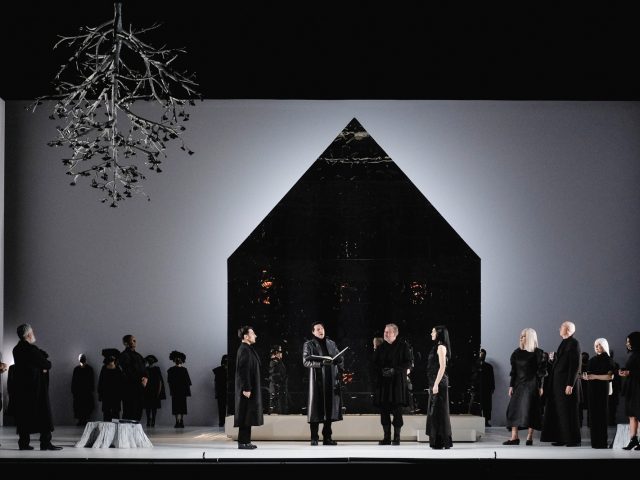Introduction to Madama Butterfly
Tue, Sep 3, 2024

When Japan opens to the West
In 1853, the American commodore Matthew Perry and his four kurofune – ‘black ships’ as the Japanese had called these Western ships since the 16th century – landed at the harbour of Uraga in Tokyo Bay to intimidate the country of the shoguns (warlords) and force them to open up to trade. This joint military and diplomatic expedition resulted in several treaties being signed with Western powers and put an end to two centuries of a policy of national isolation or sakoku (‘closed country’), implemented at the beginning of the Edo period. Until this time, the artificial island of Dejima off the coast of Nagasaki was the only trading post with ‘the rest of the world’, i.e. Chinese and Dutch traders, tolerated by Japan. This harbour town was founded by the Portuguese in the 16th century and was later to become a martyr to the nuclear blast and American supremacy. Now prey to the colonial appetites of the Western world, Japan was propelled into a forced march towards modernisation. The feudal system of the shoguns gave way to imperial restoration in 1868, inaugurating the Meiji era. Japanese citizens were sent all over the world to become familiar with the methods and technical prowess of the West to ensure that the Empire of Japan would itself become an economic, industrial and military power capable of defending its independence.
The Great Wave of Japonisme
This move opened the gateway to intense cultural exchanges. The West was fascinated by the refined aesthetics of this far-flung corner of the world. The wave of japonisme spread from France and strongly influenced the rise of Art Nouveau in the early 20th century – at the same time as the Japanese painters of the yō-ga movement took on board European techniques. Baudelaire, Monet, then Proust and many other artistic figures developed a passion for the arts from the Land of the Rising Sun. While the Goncourt brothers made Hokusai’s woodblock prints popular, Japan was present at the Universal Exhibitions of Paris and London. Japanese fever took hold of the West, as summarised in Émile Zola’s Au bonheur des dames (1883): ‘Four years was enough for Japan to attract the artistic clientele of Paris.’
From Chrysanthemum to Butterfly
This trend was also motivated by the success of a book by the writer and French naval officer Pierre Loti (1850-1923). He stayed in Nagasaki in the summer of 1885. Arriving on 9 July, he signed a monthly renewable marriage contract to a young Japanese woman, Okane-San nicknamed Kiku-San or ‘Madame Chrysanthemum’. This flower had decorated European tombs since the mid 19th century and was the Japanese imperial emblem symbolising happiness.
Loti returned to France on 12 August the same year. The transient union was the inspiration behind his semi-autobiographical novel Madame Chrysanthème (1888), adapted for the opera by André Messager in 1893. The story touched the American writer John Luther Long (1861-1927) who published a short story entitled Madame Butterfly in The Century Magazine in 1898, in part inspired by his sister’s memories of her stay in Nagasaki where she travelled with her missionary husband. This short story was in turn adapted for theatre by David Belasco (1853-1931) with the title Madame Butterfly: A Tragedy of Japan (1900). The play was first performed in New York, then staged in London with a thrilled Giacomo Puccini (1858-1924) in the audience.
A Cult Masterpiece in the Lyrical Repertoire
When Puccini acquired the adaptation rights to Belasco’s play, he was basking in the success of Manon Lescaut (1893), La bohème (1893) and Tosca (1900). Without having ever set foot in Japan, he enthusiastically threw himself into the study of the country’s customs and folklore, as they were perceived in Europe. He used Japanese rhythms and instruments to give ‘local colour’ to his score, notably bells, a gong and bird whistles. This he set in contrast to the melody of The Star-Spangled Banner, the U.S. Navy hymn which became the American anthem in 1931. Madama Butterfly was composed from 1901 to 1903. The first performance of the opera at La Scala in Milan on 17 February 1904 was a fiasco orchestrated by the rivals of Puccini and his publisher. The composer reluctantly reworked his score into three acts. This new version staged three months later in Brescia was a triumph and within the next few years, Madama Butterfly was performed throughout the world. Today, it is one of the most regularly performed works in the lyrical repertoire, and has become a cult opera thanks to magnificent arias such as ‘Un bel dì, vedremo’.
Story within a Story of a Culture Shock
Mariano Pensotti created Madama Butterfly a first time for the Opéra national du Rhin during the pandemic. From Argentina and via online tools, he directed Puccini's masterpiece, which he is now recreating for Opera Ballet Vlaanderen. Together with conductor Daniela Candillari, Pensotti offers a sophisticated, conceptual vision. At the center is the tragic fate of a Japanese director living in the West. Madama Butterfly here becomes an opera within an opera. In this new performance, he offers a profound reflection on identity, otherness and the construction of a self-image through the eyes of others.
Louis Geisler (2021), translation: Helen Sontag
Reproduced with the permission of the Opéra national du Rhin
Updated (2024) Koen Bollen / editor: Ilse Degryse